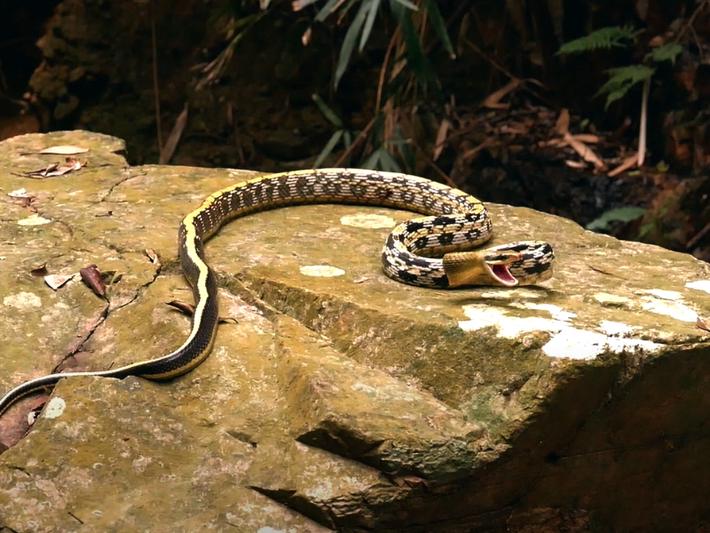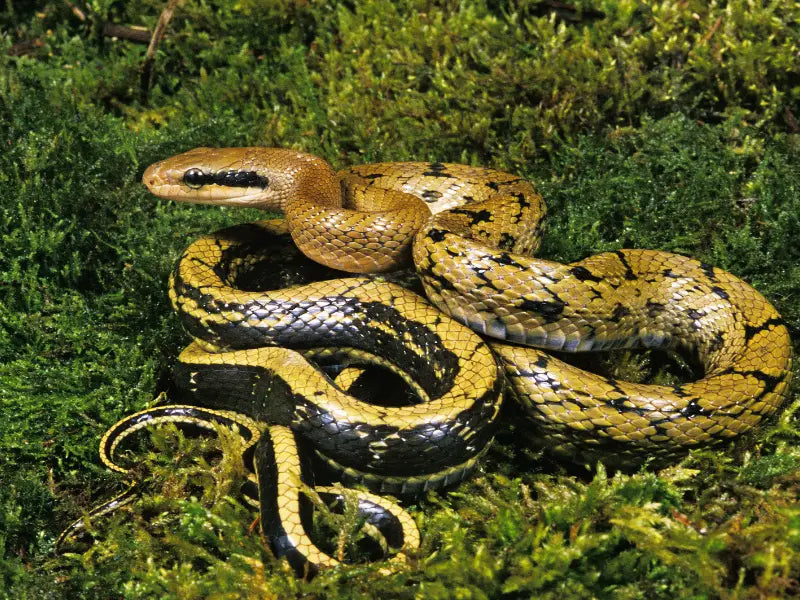Description
-
* Please Call or message us regarding Avalibilty*
* Please note all reptiles in the Eastern Cape or leaving the eastern cape do require permits. This may take up to two weeks for it to be approved and needs to be approved before reptiles can leave the building, Please inquire *
The Taiwan beauty snake is a beautiful snake with a pattern of olive-brown splotches over yellow coloring. It has several distinctive dark lines running from its eyes to its mouth.These snakes have relatively standard care requirements but can be a bit shy and moody. This temperament makes them best suited for those with intermediate experience owning and handling snakes.
Appearance And Behavior

The Taiwan beauty snake is a thin-bodied snake with yellow coloring. It has several brown splotches that get darker along the bodies.
Size And Lifespan
Taiwan beauty snakes live between 15 to 25 years. Getting one of these snakes as a pet is a long-term, serious commitment. With proper care, these snakes can live very long and happy lives.
In contrast, captive-bred snakes aren’t aggressive but are rather quite shy. This attitude makes them unsuitable as beginner-friendly pet snakes.
You will have to put in a lot of work to bond with your snake.
Housing The Taiwan Beauty Snake

Taiwan Beauty snakes cope best in warmer environments.
If you live in a cold place, a wooden vivarium is a good choice of enclosure because it is better at holding in heat. However, if you live in a temperate area, there is nothing wrong with a standard snake terrarium.
Enclosure Size
Because of their climbing nature, Taiwan beauty snakes require tall enclosures. A suitable size enclosure for an adult snake is 4 ft long, 2 ft wide, and 3 ft tall.
Since the Taiwan beauty is a large, active snake, it needs enough space to move around.
In particular, these snakes require tall enclosures because of their climbing instinct.
Your enclosure must be large enough to include branches for them to climb and elevated perches for them to rest on.
Lighting
Even though these snakes are cathemeral, keeping the enclosure lights on a natural cycle is a good idea. This allows them to have a sleep-wake cycle that resembles what they would experience in the wild.
To help with this, keep the lights on for 12 hours daily, allowing your snake plenty of time to bask.
Place the lighting fixture on the warm side of your enclosure. You must ensure that it doesn’t increase the temperature above the ideal levels.
Use a thermometer to ensure that you’re getting an accurate temperature reading in your enclosure.
Unlike many other reptiles and snakes, the Taiwan beauty does not require special UVB lighting.
Temperature And Humidity
Because these snakes originate in Asia, they need quite a high ambient temperature in their enclosure. As with other snakes, you must ensure that one side of the enclosure is kept warm and the other cooler.
For Taiwan beauty snakes, the warmer side of the enclosure should be between 85°F and 90°F. To help you maintain this temperature, you can use a heating pad or mat, or a basking lamp. It’s essential to put this on one side of the enclosure and not in the middle.
Your snake can move between the warmer and cooler areas inside the enclosure to regulate its body temperature. As a cold-blooded animal, it relies on external heat sources to thermoregulate.
For the cooler side of the enclosure, you should maintain a temperature of 75 – 80°F. To monitor this, you invest in thermometers designed for snake enclosures. Heat exhaustion is a real risk to snakes, so you should never guess the temperature in the enclosure.
The enclosure should be cooler at night, with a temperature of 68 – 72°F. This cooler temperature simulates an environment closer to life outside in the wild.
Taiwan beauty snakes need a humidity level of around 50 – 60%, and you can measure this using a hygrometer
When Taiwan beauty snakes shed, they need a much higher humidity level to help with the process. When shedding, they require 70 – 80% humidity to help them shed more quickly.
You’ll be able to tell when your snake is preparing to shed when its scales go dull, its eyes become cloudy, and they become less active.
Cleaning
It’s vital to keep your pet Taiwan beauty snake’s enclosure clean. Do daily spot cleaning and remove any droppings.
Deep clean the enclosure once a month. Using household cleaners can be dangerous for the snake. Always use cleaning products designed for reptile enclosures.
During this monthly deep clean, replace the substrate. It’s crucial to thoroughly sanitize everything in the enclosure to ensure that no buildup of germs and bacteria harms your snake.
You can place your snake in a plastic bucket with ventilation holes when cleaning the enclosure.
Lastly, replace the water in the bowl daily to ensure the snake has access to fresh, clean water.
Taiwan Beauty Snake Care
Taiwan beauty snakes are best for people with some snake-handling experience. While they are unlikely to be aggressive, they can be a bit unpredictable when they feel threatened. If you ensure that the following conditions are met, your pet snake can live a long, happy life.
Food And Water
Hatchlings and juvenile Taiwan beauty snakes should be fed pinky mice every 5 days. Feeding more often than this can lead to health problems, including obesity.
A good rule of thumb when it comes to feeding snakes is that the food you are feeding is no wider than the circumference of the snake at its widest point. This rule is valid throughout your snake’s lifespan.
Adult Taiwan beauty snakes should be fed frozen rats weekly or every 10 days. You will need to judge how often to feed based on your specific snake. Rats are more nutritional than mice, but a varied diet will also benefit your snake. You could introduce baby chicks as a treat when your snake is fully grown.
With the Taiwan beauty snakes, it’s imperative to use tongs when feeding. This prevents them from associating your smell with food. When they associate your smell with food, they may strike out and bite you, thinking it’s food.
If you choose to feed outside the enclosure, you can place the snake in a plastic container lined with newspaper. Always ensure that the tub you are using has adequate ventilation.
Don’t handle your snake for 24 hours before feeding and around 48-72 hours afterward. Holding the snake while digesting its last meal can disturb the process and cause regurgitation.
For water, you must provide your snake with a drinking bowl large enough for them to soak in and heavy enough that it can’t knock it over. You should change this water daily to ensure it is always clean and fresh.

